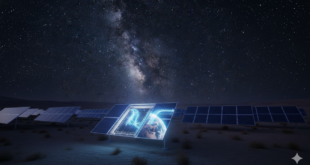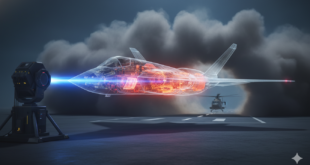🔹 Watch the Explainer Video
Discover how electric propulsion is empowering a new generation of small spacecraft for deep space missions and intelligence operations.
Introduction
The exploration of the Moon, Mars, and beyond has always captured the human imagination, but it has also presented daunting challenges, particularly when it comes to propulsion. Traditionally, massive rockets producing millions of pounds of thrust were the go-to option for venturing into deep space. However, a new era of space exploration is upon us, characterized by a diverse fleet of spacecraft, including nanosatellites, microsatellites, and even smaller vehicles.
Smallsat Propulsion
The development of electric propulsion systems for small spacecraft has revolutionized our capabilities, from deep space exploration to covert spy missions. This technology offers a promising solution to the constraints of conventional propulsion systems, providing greater efficiency, extended mission lifetimes, and enhanced maneuverability. In this article, we will explore the significant impact of small spacecraft electric propulsion on both scientific and military applications.
For smallsat propulsion to be effective, several factors must be considered. These include onboard power availability, volume, size, weight, electromagnetic interference, cost-effectiveness, and the specific mission goals. Interplanetary missions, in particular, demand additional considerations such as radiation tolerance and telecommunications design.
Enter Electric Propulsion
Traditional chemical propulsion systems, while powerful, have limitations in terms of fuel capacity and the ability to alter course mid-mission. Electric propulsion systems, on the other hand, utilize electricity to accelerate ions or other propellants, offering a more efficient way to generate thrust.
Space EP is defined as any system that accelerates a propellant through the conversion of electric potential energy into kinetic energy. Broadly, this energy conversion can be electrostatic, electrothermal, or electromagnetic-based. It could also be a combination of both (e.g., electrothermal coupled with electromagnetic).
Electric propulsion is heralding a power revolution in orbit, and ion thrusters are at the forefront of this transformation. These thrusters generate thrust by accelerating ions using electricity. As ionized particles are expelled from the spacecraft, they create a propulsive force in the opposite direction. While electric solar panels usually supply power to ion thrusters, nuclear power is utilized in missions that venture far from the sun.
Advantages of Small Spacecraft Electric Propulsion
Compared to traditional chemical propulsion systems like SpaceX’s Falcon Heavy or NASA’s Space Launch System (SLS), electric propulsion offers several advantages. Electric propulsion systems boast higher fuel efficiency, lower fuel and propellant storage requirements, and can operate continuously for extended periods. This efficiency translates into significant savings, reducing launch vehicle size and costs.
As Michael Patterson, senior technologist for NASA’s In-Space Propulsion Technologies Program, aptly puts it, electric propulsion can be likened to the tortoise in the “Tortoise and the Hare” fable. While traditional chemical propulsion systems provide high thrust for a short duration, electric propulsion systems offer steady thrust over an extended period, resulting in a substantial increase in velocity.
The efficiency of electric propulsion systems reduces costs and opens the door to more economical satellite programs. “To do the same amount of velocity increase on the satellite, we use a fraction of the propellant because it’s five to ten times more efficient.” But this efficiency, translates into big savings, says Ben Olivier, CEO Thales Belfast: “What difference does it make commercially? It probably takes 20% out of the cost of the program because you can use a smaller launch vehicle to put you into your injection orbit, and then do more of the work with your own propulsion sub-system.”
Electric propulsion systems have been in use for decades, but recent advancements have made them more compact, efficient, and reliable, making them ideal for small spacecraft.
- Enhanced Efficiency: Electric propulsion systems are incredibly efficient, providing a continuous low-thrust propulsion, which may operate for extended periods, making them perfect for long-duration missions. These systems offer a higher specific impulse (Isp), meaning they can achieve higher velocities while consuming less fuel.
- Extended Mission Lifetimes: Small spacecraft, powered by electric propulsion, can stay operational for several years, even decades. The extended mission lifetimes are advantageous for both deep space exploration and surveillance missions, as they allow for prolonged data collection and analysis.
- Maneuverability: Electric propulsion enables precise course corrections and orbit changes, which are essential for exploration missions and covert spy missions alike. These systems can efficiently adjust trajectories, making them valuable tools for mission success.
While small spacecraft electric propulsion has already demonstrated its effectiveness, there are still challenges to overcome, including developing even more efficient propulsion systems and minimizing power requirements. Researchers and engineers are continuously working on improving these technologies, which will have a lasting impact on space exploration and defense capabilities.
Applications in Deep Space Exploration
Small spacecraft equipped with electric propulsion systems are fundamentally transforming scientific missions in deep space. These innovative propulsion systems enable spacecraft to achieve the high delta-v necessary to explore distant celestial bodies—such as asteroids, comets, and planets—with unprecedented efficiency. Missions like NASA’s Dawn, which explored the asteroid belt, and the upcoming Europa Clipper, destined for one of Jupiter’s moons, exemplify how electric propulsion facilitates complex orbital maneuvers, precise flybys, and extended mission durations while using far less power than conventional chemical rockets. This technology not only improves fuel efficiency but also opens up new possibilities for gathering high-resolution scientific data across the solar system.
Beyond our solar system, electric propulsion holds the potential to spearhead interstellar exploration. Initiatives like Breakthrough Starshot envision using fleets of ultra-light spacecraft propelled by highly efficient electric propulsion systems to reach the nearest star system, Alpha Centauri, within a human lifetime. Although still in its infancy, this approach represents a monumental leap towards overcoming the vast distances of space, potentially enabling humanity’s first forays into interstellar travel. As these technologies mature, they promise to extend our reach into the cosmos, offering deeper insights into planetary formation, cosmic phenomena, and the possibility of extraterrestrial life.
Applications in Spy Missions
Electric propulsion is also emerging as a game-changing asset in the realm of covert surveillance and rapid response for national security. Small, agile spacecraft equipped with this technology can be deployed into low Earth orbit for continuous intelligence and reconnaissance operations. Their extended operational lifetimes and precise maneuverability allow them to monitor potential threats and gather critical data on adversary activities, all while maintaining a low acoustic and electromagnetic signature. This stealth capability is essential for modern spy missions, where the ability to operate discreetly and remain undetected is of paramount importance.
In addition to enabling covert surveillance, electric propulsion systems offer significant advantages for rapid response scenarios. These small spacecraft can be swiftly repositioned in orbit to address emerging threats or crises, providing timely situational awareness and real-time intelligence. This agility not only enhances a nation’s defensive capabilities but also ensures that decision-makers have immediate access to updated information, facilitating quicker and more effective responses. Together, these capabilities underscore the critical role that electric propulsion will play in modernizing national security strategies and maintaining a competitive edge in the rapidly evolving defense landscape.
Race to employ Electric propulsion for deep space exploration
NASA is actively enhancing solar electric propulsion (EP) technologies for deep space exploration. NASA’s Glenn Research Center has been at the forefront of developing high-power electric propulsion systems that harness solar energy to convert inert gases into efficient thrust. These improvements aim to reduce transit times, increase payload capacity, enhance spacecraft safety, and lower mission costs by requiring less propellant. Key projects, like the 7-kilowatt (kW) NEXT-C gridded-ion system on the Double Asteroid Redirection Test mission and the 12-kilowatt Advanced Electric Propulsion System on NASA’s Gateway lunar orbiting space station, showcase the agency’s focus on utilizing electric propulsion for exploration and science missions.
Additionally, NASA is advancing electric propulsion for deep space missions near the moon, ultimately preparing for human missions to Mars. The agency envisions the development of an integrated electric propulsion system, including thrusters, power processing units, xenon flow controllers, and electrical harnesses, to support these ambitious missions. The aim is to construct a reusable spacecraft that combines electric and chemical propulsion to facilitate crewed missions to destinations such as Mars, making use of advanced exploration technologies and the high launch capacity of the Space Launch System (SLS) rocket. Through collaborations with companies like Accion, NASA is exploring more efficient ion electrospray propulsion systems to further enhance deep space capabilities.
Over the past five years, NASA’s Small Spacecraft Electric Propulsion (SSEP) project, based at NASA Glenn, has made significant strides in advancing high-performance sub-kilowatt (<1-kW) Hall-effect thruster and power processing technologies, making deep space missions with smaller spacecraft a cost-effective reality. Collaborating with U.S. industry, SSEP has developed a lightweight thruster capable of propelling small spacecraft to destinations like the Moon and Mars, surpassing existing low-power electric propulsion systems tailored for low-Earth orbit missions. Through technological miniaturization, including optimized magnetic field topology and center-mounted cathodes, originally designed for higher-power applications, SSEP propulsion systems achieve the required performance, longevity, and fuel efficiency for planetary missions.
The newfound capability opens doors to missions ranging from lunar communication satellite clusters for data relay to deep space explorations to Venus, Mars, asteroids, and beyond, enabling multiple spacecraft to self-propel to diverse destinations after deployment from a single large rocket. These innovations also hold commercial potential for orbit adjustments, spacecraft servicing, and missions beyond low-Earth orbit, with Northrop Grumman actively developing and testing SSEP-based electric propulsion technologies for their customer satellite systems, with plans for mission launches in 2024. The SSEP project receives joint sponsorship from Northrop Grumman, NASA’s Space Operations Mission Directorate, Space Technology Mission Directorate, and the Science Mission Directorate.
The adoption of electric propulsion in the satellite industry has significantly advanced in recent years, despite having a history of use in long-duration space exploration missions and station keeping. Electric propulsion systems are particularly known for their high efficiency in deploying geostationary telecommunications satellites into orbits at around 36,000 kilometers above the Earth’s surface. One noteworthy achievement in this arena was the completion of the first UK-built electric satellite propulsion module by Thales Alenia Space in November 2018, marking the UK’s entry into the league of established manufacturers like Airbus and Boeing. This module, known as the Spacebus NEO Xenon Propulsion (XPS), was integrated into the Spacebus NEO bus for Eutelsat’s KONNECT communications satellite, showcasing the potential of electric propulsion for commercial satellite applications.
Furthermore, SSL (Space Systems Loral) demonstrated its solar electric propulsion system on two communications satellites launched into geostationary orbit in 2018. Their SPT-140 electric thruster, an enhanced version of the SPT-100, has supported numerous missions and logged an impressive 100,000 hours of firing time. SSL is actively involved in developing a 6kW dual-mode electric propulsion engine as part of NASA’s Tipping Point program, which will be used to power commercial satellites. The significance of electric propulsion in microsatellites is emphasized by India’s space tech startup, Bellatrix Aerospace. In May 2021, they successfully tested India’s first privately built Hall Thruster, a highly efficient electric propulsion system designed for micro-satellites. This innovation holds promise for scaling up propulsion technology to cater to heavier satellites and satellite constellations.
Blue Canyon Technologies, a Colorado-based small satellite supplier, is actively pursuing missions that involve the use of electric propulsion to transport spacecraft from low Earth orbit (LEO) to geostationary orbit (GEO) and even to the Moon. George Stafford, Blue Canyon’s CEO and president, has revealed that these missions are scheduled to take flight within the next few years. Leveraging electric propulsion, satellites can make the journey from LEO to GEO in approximately four months and reach the Moon in about six months, according to Daniel Hegel, Blue Canyon’s advanced development director. This marks a significant shift from the traditional reliance on powerful rockets to achieve such orbital transitions.
In parallel, a small company based in Colorado, Roccor, specializes in deployable space structures and has introduced an innovative product: a compactly stowed full solar wing that can be deployed in orbit. After a rocket delivers the spacecraft to LEO, Roccor’s solar arrays generate several kilowatts of power to facilitate the satellite’s journey to GEO. The impetus behind these advancements is the recognition that launching satellites to geostationary orbits can be cost-prohibitive. This has led to a reluctance among geostationary satellite operators to invest in new spacecraft. The introduction of more efficient electric propulsion systems offers a solution to bridge this gap, providing a more cost-effective means to transport satellites to their desired orbits.
Nanosatellites equipped with ion thrusters are seen as the future of deep space exploration, with the potential to revolutionize space research. Despite their promise, CubeSats, which are often launched as secondary payloads, face limitations due to their lack of self-propulsion once in space. However, researchers like Paulo Lozano and his team at the Massachusetts Institute of Technology have developed mini thrusters that create an electric field, generating a spray of charged ions. While the force produced by these ion thrusters is relatively small, the vacuum of outer space allows for fast movement, enabling CubeSats to maneuver efficiently. This technology, resembling computer microchips with a grid of 500 tiny nozzles, holds promise for interplanetary travel and deep space missions.
Electric propulsion systems like the XPS propulsion module manufactured in Belfast are driving advancements in space exploration. These modules, while not small, offer substantial thrust and fuel efficiency for larger missions. The Spacebus NEO satellite, powered by an all-electric system, is paving the way for future deep space endeavors. With multiple follow-on orders for similar XPS modules, the use of electric propulsion is expected to become increasingly prevalent in space exploration, offering a more efficient and cost-effective means of propulsion for a wide range of missions.
In parallel, India’s ISRO is nearing completion of a 300mN high-thrust electric propulsion system for satellites. This development is poised to eliminate the use of chemical fuels in satellites, leading to lighter spacecraft and reduced fuel weight. Israel is also taking substantial strides in electric propulsion, with the Israel Space Agency (ISA) preparing to demonstrate its 100 percent electric propulsion system on an ISRO-operated small satellite within the next three years. The success of this demonstration will underscore the technology’s capability to maintain satellites in orbit and perform maneuvers relying solely on electric propulsion. Additionally, Israel Aerospace Industries (IAI) is working on upgrading the optical and radar payloads of spy satellites, with plans to develop a new generation of satellites employing nanosatellite production and electric propulsion concepts. These advancements collectively highlight the pivotal role of electric propulsion in satellite development and space exploration.
NASA’s Advanced Electric Propulsion: Paving the Way for Future Planetary Exploration
NASA has unveiled a breakthrough propulsion technology that is set to transform the way we explore space using small spacecraft. This advanced electric propulsion system, developed at NASA Glenn Research Center (GRC), is based on a sub-kilowatt Hall-effect thruster known as the NASA-H71M. Unlike traditional propulsion systems, the NASA-H71M is engineered to deliver exceptionally high delta-v—up to 8 km/s—using a compact, low-power design. This capability is critical for enabling challenging maneuvers such as planetary escape, orbit capture, and complex trajectory adjustments required for deep-space missions. The technology is the culmination of years of research and the miniaturization of advanced high-power solar electric propulsion systems, initially developed for the Power and Propulsion Element of the Gateway lunar space station.
One of the most promising aspects of this propulsion technology is its dual-use potential. While its primary application is to enable new types of planetary science missions, it also offers substantial commercial benefits. One of NASA’s commercial partners, SpaceLogistics—a subsidiary of Northrop Grumman—is set to leverage this technology in its Mission Extension Pod (MEP) satellite servicing vehicle. The MEP, equipped with Northrop Grumman’s NGHT-1X Hall-effect thrusters (designed on the NASA-H71M platform), is designed to extend the operational lifetimes of geosynchronous communication satellites by serving as a “propulsion jet pack.” This innovative approach not only supports NASA’s mission of technology commercialization but also creates a pathway for future planetary missions by demonstrating the viability of high-delta-v electric propulsion in orbit.
The advantages of the NASA-H71M technology extend far beyond mere propulsion. Small spacecraft equipped with this advanced thruster will be capable of independently maneuvering from low-Earth orbit to the Moon or even from a geosynchronous transfer orbit to Mars. This increased propulsive capability enables a greater launch flexibility, allowing secondary science missions to deviate from the primary mission’s trajectory and explore a wider range of scientific targets. Additionally, the technology’s ability to decelerate and insert a spacecraft into orbit around a target body opens up opportunities for long-term scientific studies—capabilities that are currently beyond the reach of most commercial electric propulsion systems, which typically offer only a few thousand hours of operation.
NASA’s commitment to maturing this propulsion technology is a testament to its vision for the future of space exploration. By collaborating with industry partners and investing in long-duration wear tests, NASA is not only pushing the boundaries of propulsion efficiency but also paving the way for a new generation of small spacecraft missions. These advancements promise to reduce mission costs and increase the cadence of planetary science missions, reinforcing the United States’ leadership in commercial space systems while ensuring that critical technologies can be sourced from industry when needed for future planetary missions.
The Commercial Revolution
Electric propulsion has not only revolutionized space exploration but has also transformed the commercial satellite market. Companies like Thales Alenia Space, Airbus, and Boeing are actively manufacturing all-electric propulsion technology for commercial satellites. These advancements have made it more feasible to launch satellites into geostationary orbit, significantly reducing costs.
Moreover, startups like Bellatrix Aerospace in India are pushing the boundaries by developing highly efficient electric propulsion systems suitable for microsatellites. Their Hall Thruster, powered by saltwater, offers a high thrust-to-power ratio, ideal for powering the satellite constellations expected to launch in the coming decade.
Market growth
The Electric Propulsion Satellites Market size is estimated at 55.23 billion USD in 2025, and is expected to reach 89.84 billion USD by 2030,
growing at a CAGR of 10.22% during the forecast period (2025-2030). The market is driven by the growing preference for hosted payload. In addition, the introduction of lightweight amplifiers is anticipated to boost the growth of the electric propulsion satellite market.
The Future Beckons
With the propulsion technology revolution still in its infancy, exciting prospects await. As we scale down electric propulsion technologies to fit smallsats, a host of opportunities emerge for ambitious deep space missions. The ability to launch clusters of smallsats into space, each propelled to different destinations of interest, opens a new frontier in exploration.
In summary, small spacecraft electric propulsion is a game-changer for space exploration, bringing the Moon, Mars, and beyond within reach. Its cost-effectiveness, extended mission lifetimes, and versatility in maneuverability make it a crucial component in the future of space exploration. As we continue to innovate and push the boundaries of what’s possible, the smallsats powered by electric propulsion systems are bound to lead the way in our journey to the stars.
 International Defense Security & Technology Your trusted Source for News, Research and Analysis
International Defense Security & Technology Your trusted Source for News, Research and Analysis




